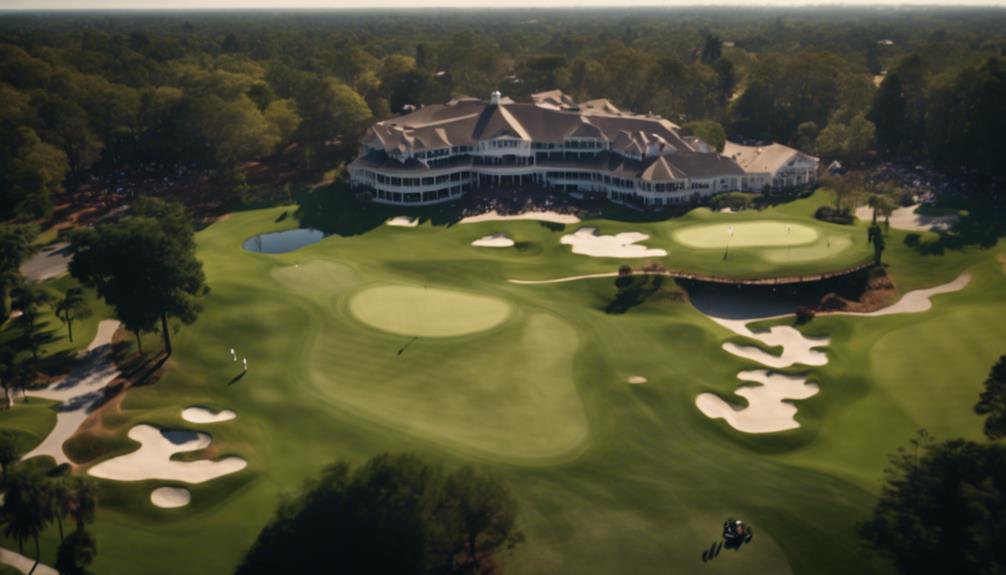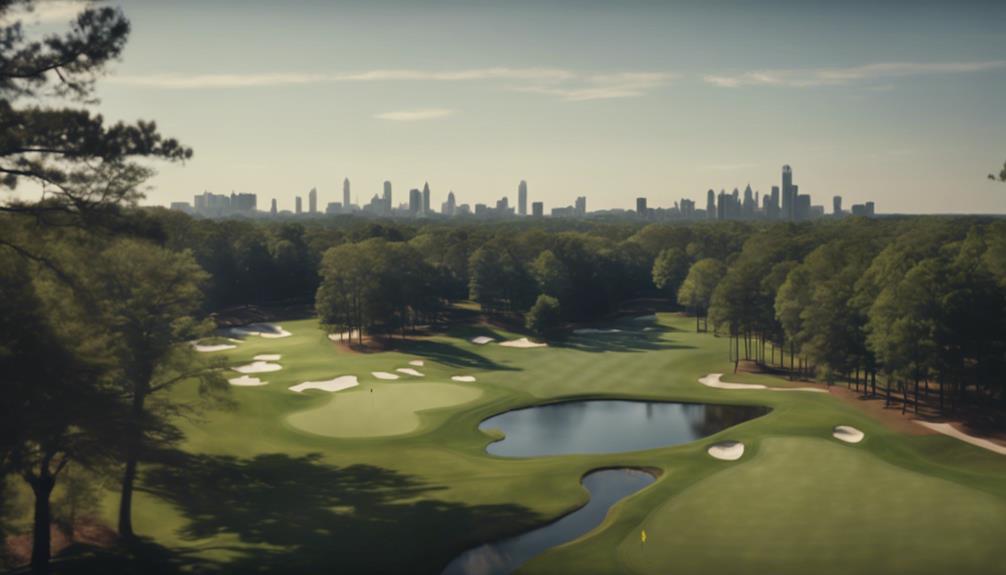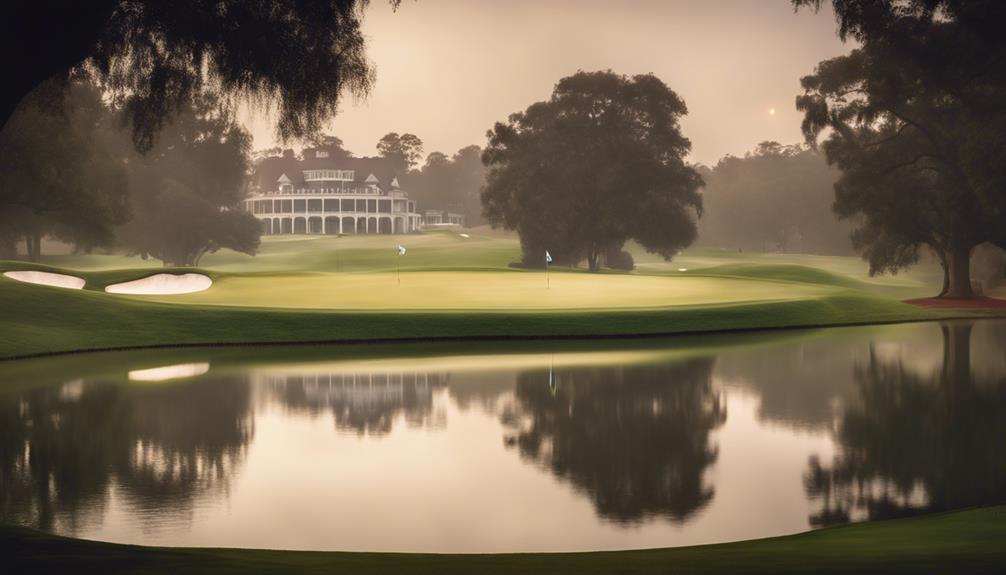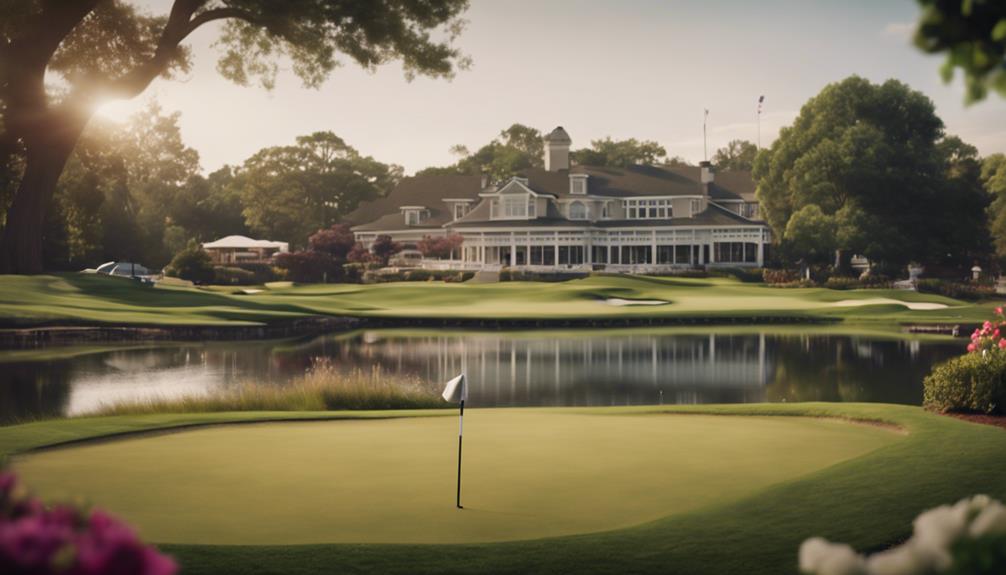- 7 Top Flite Golf Clubs XL for Improved Performance - September 28, 2024
- Top Flite Golf Clubs: Top 5 Reasons to Choose Them - September 28, 2024
- Top 3 Golf Club Fitters for a Perfect Swing - September 28, 2024
You'll find East Lake Golf Club in DeKalb County, Georgia, at coordinates 33°44'35"N 84°18'11"W. This premier golf destination has undergone significant transformations since its establishment in 1904. From its original design by Tom Bendelow to its redesign by Donald Ross and Rees Jones, the course has maintained its historical integrity. Having hosted major tournaments like the TOUR Championship, East Lake Golf Club is committed to community development, with its motto "Golf with a Purpose" reflecting its dedication to supporting local health and education initiatives. As you explore further, you'll uncover the rich history and impactful community efforts that make East Lake Golf Club a truly unique destination.
Key Takeaways
- East Lake Golf Club is located in DeKalb County, Georgia, with coordinates 33°44'35"N 84°18'11"W.
- The course is situated in the East Lake neighborhood of Atlanta, Georgia, near the intersection of Alston Drive and East Lake Drive.
- The clubhouse address is 2575 Alston Drive SE, Atlanta, Georgia 30317.
- The golf club is approximately 7,154 yards in length for the TOUR Championship, with a par 72 layout.
Club History and Development
Established in 1904 by the Atlanta Athletic Club, East Lake Golf Club has a rich history that spans over a century, with its original design created by architect Tom Bendelow.
You'll find it fascinating to know that the course took four years to complete, finally opening its doors in 1908.
However, it wasn't until 1913 that the course truly began to take shape, thanks to the expertise of notable golf course designer Donald Ross. Ross's reworking of the course has largely remained intact to this day, a reflection of his exceptional skills.
Unfortunately, the course faced significant challenges in the mid-20th century, including a decline in membership and surrounding neighborhood deterioration.
Thankfully, a major restoration by architect Rees Jones in 1994 brought the course back to its historic design, enhancing its facilities and restoring its former glory.
Today, you can experience the beauty and charm of East Lake Golf Club, a true gem in the world of golf.
Community Engagement and Purpose
As you explore East Lake Golf Club, you'll discover that its commitment to community engagement and support is just as impressive as its rich history, with a motto that resonates deeply: 'Golf with a Purpose.'
This dedication is evident in the club's operations, where all profits are directed towards the East Lake Foundation. The foundation focuses on enhancing health and education in the local community, and its efforts have had a profound impact.
The Charlie Yates Golf Course, a 9-hole public course, was established in 1998 to promote youth golf education and community involvement. Through initiatives like Purpose Built Communities, the club has been able to replicate its community revitalization efforts in 14 U.S. cities since 2009, demonstrating its commitment to revitalizing the surrounding area.
Major Tournaments and Events

You'll find East Lake Golf Club at the forefront of the golf world, having hosted some of the most prestigious tournaments in the sport.
As the permanent venue for the TOUR Championship, the concluding event of the PGA TOUR Playoffs, East Lake Golf Club has solidified its reputation as a premier golf destination.
Since 1998, the club has hosted the TOUR Championship 23 times, with Viktor Hovland being the reigning champion as of 2023.
Beyond the TOUR Championship, East Lake Golf Club has also hosted other significant tournaments, including the Ryder Cup in 1963 and the Southern Amateur, which has been held at the club since 1907.
Additionally, the club inaugurated the East Lake Cup in 2015, a collegiate match play event broadcast in partnership with the Golf Channel.
Through its commitment to hosting major golf events, East Lake Golf Club continues to enhance its reputation while supporting community engagement initiatives, further solidifying its position as a leader in the golf world.
Course Records and Scorecard
With its storied history of hosting prestigious tournaments, East Lake Golf Club's course records and scorecard tell a story of challenging play and exceptional performances. You'll want to know the numbers behind this iconic course.
Here are some key stats to keep in mind:
- Par and Rating: East Lake Golf Club features a par 72 layout with a black tee rating of 74.0 and a slope of 137.
- Course Lengths: The course measures 7,267 yards (6,645 m) for the U.S. Amateur and 7,154 yards (6,542 m) for the Tour Championship.
These records reflect the competitive history of East Lake Golf Club, which has hosted notable events like the Southern Open and the Western Junior.
As you step onto the course, you'll be walking in the footsteps of golf legends, and you'll need to bring your A-game to tackle the challenging layout.
Geographic and Structural Info

Located in DeKalb County, Georgia, East Lake Golf Club's picturesque setting is defined by its precise coordinates of 33°44'35'N 84°18'11'W.
As you step onto the course, you'll notice the par 72 layout, carefully crafted by renowned course architects Tom Bendelow, Donald Ross, and Rees Jones. The total length of the course for the TOUR Championship stretches an impressive 7,154 yards (6,542 m), offering a challenging yet rewarding experience for golfers of all skill levels.
The clubhouse, situated at 2575 Alston Drive SE, Atlanta, Georgia 30317, serves as the central hub for the golf club's activities. Here, you can relax and unwind after a round of golf, taking in the stunning views of the course.
With its rich history and architectural significance, East Lake Golf Club is a must-visit destination for golf enthusiasts. As you explore the club's facilities, you'll appreciate the attention to detail and commitment to excellence that defines this iconic golf club.
Historical Background of East Lake
As you explore the Historical Background of East Lake, you'll discover the fascinating story of how this iconic golf club came to be.
You'll learn about its founding, the early course design, and the growth and challenges it faced over the years.
From its humble beginnings to its current status, East Lake's rich history is full of interesting facts and anecdotes waiting to be uncovered.
East Lake's Founding
In the early 20th century, you'd find Atlanta's golf enthusiasts flocking to East Lake Golf Club, which was established in 1904 as a cornerstone of the Atlanta Athletic Club. As the oldest golf course in Atlanta, East Lake Golf Club has a rich history that's worth examining.
Here are three key facts about East Lake's founding:
- Original Design: The course was originally designed by architect Tom Bendelow and opened fully in 1908.
- Redesign by Donald Ross: In 1913, the course underwent significant redesign by Donald Ross, whose routing remains the foundation of the layout today.
These pivotal moments in East Lake's history have contributed to its reputation as a premier golfing destination.
As you explore deeper into the club's history, you'll discover more about its evolution and the people who shaped it into the iconic course it is today.
Early Course Design
You step into the historic grounds of East Lake Golf Club, where Tom Bendelow's original design laid the foundation for a legendary course that would evolve over the years. As you walk through the course, you can appreciate the vision of Bendelow, a pioneer in American golf course architecture. The course opened fully in 1908, featuring several holes crafted by Bendelow himself.
| Year | Architect | Notable Changes |
|---|---|---|
| 1904 | Tom Bendelow | Original design and layout |
| 1913 | Donald Ross | Reworked the original layout, routing remains largely intact today |
| 1994 | Rees Jones | Restoration to reflect Donald Ross's character and challenges, adapted for modern play |
However, it was Donald Ross, a renowned course architect, who reworked the original layout in 1913. Ross's routing remains largely intact today, reflecting the course's historical significance. The course has since undergone restorations, including one by Rees Jones in 1994, to bring it back to its original character and challenges while adapting it for modern play. As you navigate the course, you can appreciate the blend of Bendelow's original design and Ross's reworked layout, making East Lake Golf Club a true masterpiece of golf course design.
Growth and Challenges
What led this iconic golf course to teeter on the brink of collapse, despite its rich history and architectural significance? As you explore the growth and challenges of East Lake Golf Club, you'll discover a tale of decline and rebirth.
In the 1960s, the club faced significant decline due to urban decay and suburban flight, leading to a drastic drop in membership. The surrounding neighborhood, once a thriving community, deteriorated into a high-crime area known as 'Little Vietnam.' By 1990, the club was on the verge of insolvency, struggling financially and facing vandalism and safety issues.
Here are three key challenges that East Lake Golf Club faced:
- Urban decay and suburban flight: The club's membership dwindled as the surrounding neighborhood declined.
- Public housing projects: The presence of East Lake Meadows public housing projects contributed to the area's high crime rate and negatively impacted the club's reputation.
However, in 1993, Tom Cousins purchased the club, initiating a restoration project that included the demolition of the public housing projects to revitalize the East Lake community. This marked the beginning of a new era for the club, one focused on revitalizing the community and restoring the course to its former glory.
Legacy of Bobby Jones

At the tender age of six, Bobby Jones first set foot on the lush greens of East Lake Golf Club, marking the beginning of a lifelong journey that would etch his name in the annals of golfing history. As you walk the same grounds, you can almost feel the presence of this golfing legend.
Jones' remarkable career saw him win 13 national championships between 1923 and 1930, including four U.S. Opens and five U.S. Amateurs, solidifying his status as one of the greatest golfers of all time. But it was his Grand Slam achievement in 1930 that truly cemented his legacy, winning all four major championships in the same calendar year – a feat that remains unmatched in golf history.
Jones' connection to East Lake Golf Club continued throughout his life, serving as president from 1946 to 1947. He also left an indelible mark on the golfing world by founding Augusta National Golf Club and the Masters Tournament, further solidifying his position among the all-time greats.
Mid-20th Century Challenges
As you explore the history of East Lake Golf Club, you'll notice that the mid-20th century was a challenging time for the club.
During this period, the surrounding neighborhood underwent significant deterioration, earning the notorious nickname 'Little Vietnam' due to its high crime rate.
You'll see how this urban decline had a direct impact on the club's reputation and membership numbers.
Urban Decline Factors
During the mid-20th century, East Lake Golf Club's once-thriving membership and reputation began to unravel, succumbing to the pervasive urban decay that plagued the surrounding neighborhood. As you investigate the factors contributing to this decline, you'll discover that the club's struggles weren't solely financial. Rather, they were deeply rooted in societal issues and urban decay.
Here are three key urban decline factors that affected East Lake Golf Club:
- High-crime area: The surrounding neighborhood deteriorated into a high-crime area known as 'Little Vietnam', which negatively impacted the club's reputation and made it an undesirable location for potential members.
- Suburban flight: As the neighborhood declined, many members fled to the suburbs, leading to a significant drop in membership from over 1200 to less than 500 by the 1960s.
These urban decline factors, coupled with financial struggles, led to a near insolvency situation by 1990. However, it's crucial to recognize that the decline of East Lake Golf Club wasn't solely due to financial mismanagement, but rather a complex interplay of societal issues and urban decay.
Neighborhood Deterioration Effects
You'll witness firsthand how the once-thriving neighborhood surrounding East Lake Golf Club rapidly deteriorated in the mid-20th century, exacerbating the club's struggles. As urban decay set in, the area transformed into a high-crime zone, earning the notorious nickname 'Little Vietnam.'
The construction of East Lake Meadows public housing project in 1970 only worsened the situation, bringing increased poverty and crime to the area. This downward spiral had a devastating impact on the golf club, which struggled to attract new members despite its advertising efforts.
Vandalism and safety issues plagued the club, and by the 1970s, it was facing significant financial challenges. The socio-economic issues plaguing the neighborhood made it difficult for the club to stay afloat.
Restoration and Community Revitalization

Tom Cousins' 1993 purchase of East Lake Golf Club marked the beginning of an ambitious restoration and community revitalization effort, driven by a vision to pay tribute to Bobby Jones and transform the surrounding neighborhood. You might wonder, what exactly did this effort entail?
Here are a few key aspects:
- Establishment of the East Lake Foundation: This organization aimed to improve local health and education, providing essential programs such as early childhood education and healthcare access.
- Demolition and redevelopment of public housing: The East Lake Meadows public housing project was torn down, making way for mixed-income housing and considerably improving neighborhood conditions.
Through these efforts, the East Lake Golf Club and its surrounding community have undergone a remarkable transformation. The restoration and community revitalization have contributed to a considerable decrease in crime rates and have fostered community pride and engagement in the area.
Current Status and Impact
As you explore the current status of East Lake Golf Club, you'll discover that its reputation as a premier course has been solidified, attracting top golfers and spectators alike.
Meanwhile, the club's commitment to community outreach has led to meaningful initiatives that benefit local residents.
You'll see how these dual focuses have combined to create a lasting impact on the surrounding area.
Course Reputation
East Lake Golf Club's reputation as a premier golf venue has been solidified by its consistent hosting of the TOUR Championship, the culminating event of the PGA Tour Playoffs, since 2004. You can't help but notice the club's rich history and its significance in professional golf. As you explore the course, you'll discover its role in urban revitalization and community pride in Atlanta.
Here are some key aspects of East Lake Golf Club's reputation:
- Historical significance: The club has become a symbol of urban revitalization and community pride in Atlanta, transforming from a struggling facility to a vibrant community hub.
- Continued relevance: Viktor Hovland's 2023 win at the TOUR Championship highlights the club's ongoing importance in professional golf.
East Lake Golf Club's reputation is built on its commitment to excellence, both on and off the course. As you experience the club's beauty and history, you'll understand why it's a premier destination for golf enthusiasts.
Community Outreach
Through its community outreach initiatives, you're witnessing a transformative impact on the surrounding neighborhood, where revitalization efforts have spawned a new era of community pride and stability. The East Lake Foundation, established in 1993, has been instrumental in driving this change. Its community engagement initiatives, including golf and life skills instruction, entrepreneurship, and financial literacy training, have empowered local residents and contributed to a significant decrease in crime rates.
| Initiative | Focus | Impact |
|---|---|---|
| Early Childhood Education | Providing educational resources | Improved academic performance |
| College Readiness | Preparing students for higher education | Increased college enrollment |
| Healthcare Access | Providing access to healthcare services | Improved health outcomes |
The Charlie Yates Golf Course, opened in 1998, serves as a public 9-hole course, promoting youth golf education and providing access to the sport for the local community. The East Lake Foundation's model has been so successful that it has been replicated in 14 U.S. cities through Purpose Built Communities, founded in 2009, demonstrating the impact of community-focused revitalization. The low-income housing project has also been transformed, becoming a symbol of the community's revitalization.
Frequently Asked Questions
What Is the History of East Lake Golf Club?
You'll discover East Lake Golf Club's rich history dates back to its founding year of 1904, featuring notable tournaments like the Ryder Cup, with architectural design influenced by Tom Bendelow and Donald Ross, and iconic golfers like Bobby Jones.
Can Non-Members Play East Lake Golf Club?
You're not exactly getting a VIP invite to play East Lake Golf Club anytime soon, unless you're a member or their guest. Public access is limited, but you can try booking through local tournaments or events, or explore membership benefits for exclusive tee times.
Is East Lake the Same as Atlanta Athletic Club?
You might think East Lake is the same as Atlanta Athletic Club, but no, they're separate entities with distinct memberships and focuses, despite sharing a historical connection and golf course designs.
How Much Is a Round at East Lake?
You're enthusiastic to tee off at East Lake, but here's the irony: you can't just book a round without being a member or guest. Green fees are unknown, but membership options and a strict booking process await; call 404-378-8687 to explore.
Conclusion
As you walk off the 18th hole at East Lake Golf Club, you're not just finishing a round – you're part of a legacy.
Like a perfectly placed approach shot, the club's rich history, community engagement, and storied tournaments have all landed in harmony.
And just as Bobby Jones' spirit still echoes through the course, you can feel the impact of this iconic club resonating far beyond its borders, shaping the game and the community for generations to come.




